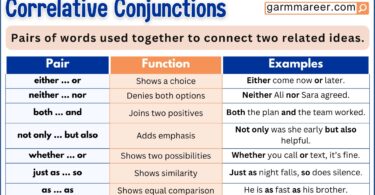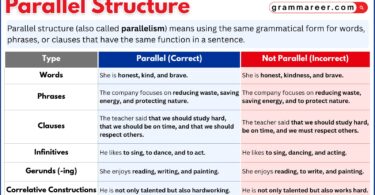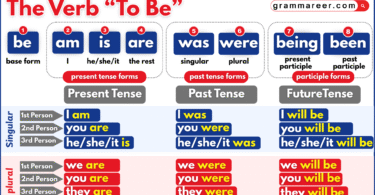There are four main sentence structures in English grammar: simple, compound, complex, and compound-complex. Today we’ll look at simple sentences. Think of your favourite food. If you had it every night for a year, you’d probably get tired of it. The same goes for writing—too much of one type makes it dull. Skilled writers mix all sentence types for variety.
Let’s explore simple sentences in detail their meaning, usage, examples and structure—so you can understand exactly how they work.
Table of Contents
What Is a Simple Sentence?
A simple sentence is a basic sentence with one verb and one main idea. It can tell a fact, give information, or talk about everyday things.
Here are a few dictionary definitions for better understanding.
Definition of a Simple Sentence
According to the Cambridge Dictionary, a simple sentence is one that has only one verb. The Collins Dictionary explains it as a sentence with a single main clause, and the Macmillan Dictionary adds that it consists of just one independent clause.
Put simply, all three agree that a simple sentence is just one complete thought, clear and straightforward.

Why do we use simple sentences?
We use simple sentences to make our message clear, direct, and easy to follow. They let us express one complete idea without any confusion.
Example:
- The sun is shining.
In just four words, you know exactly what’s happening — no extra effort needed. Simple sentences are perfect when you want your reader or listener to understand you instantly.
Points to Keep in Mind When Forming Simple Sentences
When we talk or write, we mostly use simple sentences. The forming way of simple sentence easier than it sounds. Here’s how:
- Every simple sentence needs at least one subject and one predicate.
- You can have more than one subject if you join them with conjunctions — this is called a compound subject.
- You can also have more than one verb that share the same subject — this is called a compound predicate.
- Keep it to one independent clause — no dependent or subordinate clauses.
- Make sure it expresses one complete thought.
- A simple sentence can be a statement, a question, or an exclamation, so you can use punctuation like a period, comma, question mark, or exclamation mark.
- The structure can be short (SV, SVO, SVC) or longer (ASVIODO, SVIODO, SVAA).
- You can also add details with prepositions, adverbs, adjectives, adverb clauses, or prepositional phrases.
Simple sentences are the building blocks of clear communication — once you master them, you’ll write and speak with ease.
Simple sentences vs. other sentence structures
Let’s go over what sets the simple sentence apart from the three other basic sentence structures.
Simple sentences vs. compound sentences
A simple sentence is just one independent clause. A compound sentence links two or more independent clauses together without adding any dependent clauses.
Examples:
- Simple: I baked a cake. It smelled amazing.
- Compound: I baked a cake, and it smelled amazing.
Simple sentences vs. complex sentences
A complex sentence has one main independent clause and at least one dependent clause, joined by a subordinating conjunction like because or although.
Examples:
- Simple: I stayed home.
- Complex: I stayed home because it was raining.
Simple sentences vs. compound and complex sentences
A compound-complex sentence is exactly what it sounds like — a mix of a compound sentence and a complex sentence. That means it has at least two independent clauses and at least one dependent clause.
Examples:
- Simple: The sun is rising.
- Compound and complex: While the sun is rising, the birds start singing, and the neighborhood begins to wake up.
Why Simple Sentences Are Important
Here’s a good reason why simple sentences actually matter:
Know exactly when to put a comma before “and“: If you can recognize a simple sentence, you’ll know exactly when to use a comma before words like and, or, and but. It makes punctuation so much easier!
Let’s check out some examples:
- Ayesha likes biryani and enjoys cooking. ✅
- Ayesha likes biryani but dislikes pizza. ✅
(These are both simple sentences with compound predicates. There’s just one subject — Ayesha — doing two actions. Notice there’s no comma before “and” or “but.”)
Now compare them with these:
- Ayesha likes biryani, and she enjoys cooking. ✅
- Ayesha likes biryani, but she dislikes pizza. ✅
(These are compound sentences because there are two subjects — Ayesha and she — each with its own verb. That’s why there’s a comma before “and” or “but.”)
Note: Use a comma before an “and” (or “but,” “or,” etc.) that joins two independent clauses (i.e., clauses that could stand alone as sentences). and Remember, In a compound predicate, the second part can’t be a full sentence by itself because it doesn’t have its own subject.
A simple sentence is just what it sounds like a clear, straightforward statement. You can use it to talk about everyday things, share facts, or give information. It only has one main verb and one independent clause. Sometimes it’s super short, like just a subject and a verb (“Ali runs”), and other times it can be a bit longer while still keeping just one main idea.
A simple sentence is a sentence that has one independent clause — it contains a subject and a predicate (verb) and expresses a complete thought.
Here are some examples of simple sentences:
I love reading.
The sun is shining.
We played football.
She baked a cake.
Birds are flying.
He runs every morning.
My phone is on the table.
They went to the park.
The baby is sleeping.
Water boils at 100°C.
Final Thoughts
As we learned, simple sentences are just sentences with one main idea — usually a subject and a verb. They’re short, clear, and easy to understand. You can use them to tell something, ask something, or even show excitement. Once you get the hang of them, you’ll see how they make your writing cleaner and more enjoyable to read.
You May Also Like
What is Noun Phrase?
Types of Nouns in English
Types of Phrases in English




